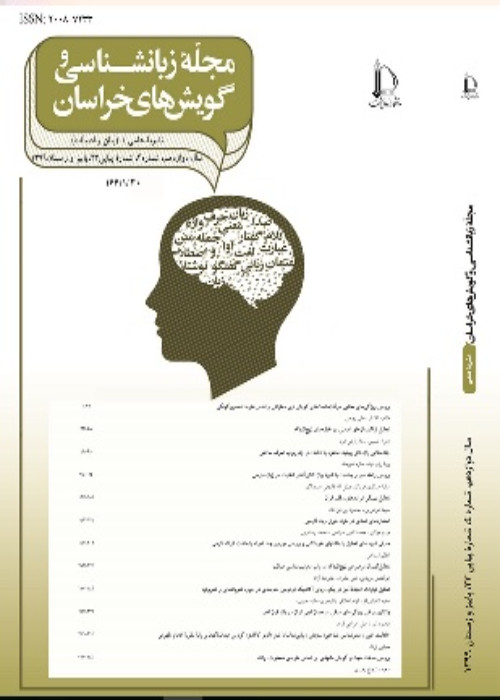Historical phonology of Bampuri dialect
Author(s):
Article Type:
Research/Original Article (دارای رتبه معتبر)
Abstract:
Introduction
Baluchi language,one of the oldest Iranian languages, is a new northwestlanguage, and its speakers are often dispersed in Sistan-Baluchistan province, and different provinces of Pakistan and Afghanistan and the coastal cities of the Oman Sea. From the point of view of historical linguistics, some similarities can be found among this language and the Avestan and the Parthian languages, but it has also some elements of the ancient Persian language and Middle Persian language.
The Bampuri dialect, one of the southern dialects of the Baluchi language, is the common dialect in Bampur, where is located in the central part of Iranshahr, and the dialects of Dalgani, Lashari and Roudbari are itslinguistic neighbors. One of the issues that is important in the classification of languages and dialects is the phonological study and the purpose of the present study is to investigate some Iranian ancient phonemes in the Bampuri dialect (a diachronic study), and to compare those phonemes in neighboring dialects (a synchronic study).
Theoretical Framework
According to the most accepted categorization, Iranian languages are historically divided into three periods of ancient, middle, and new, and the Baluchi language, which belongs to the northwest Iranian languages, should be similar to Avestan and Parthian languages, while the language has similarities with the southwest languages. In this study, the old phonemes, are the phonemes (vowels, consonants, and consonant clusters) that have been mentioned in historical grammars and historical phonology, related to the evolution of those phonemes up to New Persian period. The criteria for recording any phoneme, is its apparent differences or significant similarities with Ancient or Middle period. In order to emphasize on the antiquity of the phonemes, the order of examining phonemes is from the ancient period to the new period, and then the common phonemes in this dialect is compared with their equivalents in adjoining dialects.
Methodology
This study is a field-library research, in which data werecollectedby interviews, questionnaires, and note-taking. The participants in this study were mostly elderly or low-educated people who were randomly selected. The data were analyzed descriptively andalso the comparison method (comparison with languages of different periods / comparison with neighboring dialects) was used in this research.
Results and Discussion
In the Bampuri dialect, the compound vowels / iǝ / and / uǝ / ,arethe remnant of compound vowels of Ancient Iranians, which have become passive vowels in the Middle Persian. In this dialect, there are traces of the process of the ancient Persian vowel gradation, which appeared in the southern dialects of the Baluchi language, such as Lashari, and disappeared in the Dalgani dialect. In this dialect, there is also anumlaut process, according to which the words with /ū/ ancient are pronounced with /ī/, and creates two kinds of pronunciation for a word. In the Bampuri dialect /v/ Ancient Persian origin is usually converted to /g/ or /gw/, and this feature is also found in Rudbari language and Pazand texts. In this dialect, as in many Baluchi dialects, fricative consonants /f/ and /x/ of ancient Iranian dialects are converted to stop consonants /p/ and /k/ or fricative consonant /h/. The stop consonants of /p/, /t/ and /k/ in ancient Persian, which have become voiced after a vowel, have remained unchanged in this dialect, and this is one of the remarkable features of this dialect which is not with such breadth in the Roudbari language. Other common developments in this dialect include the remaining of mid /g/ and /č/ and the conversion of / hv / ancient Iranian origins to / w / or / h /.
Conclusion and Suggestions
According to the findings, it can be said that the ancient Iranian phonemes in the Bampuri dialect have been found in two ways:
1- This dialect retains some of the Persian phonemes of the ancient period, which have undergone a different evolution in the Middle and New Persian, for example, the mid phonemes of /p/, /t/, /d/, /g/, /k/ and /č/.
2- The evolution of some Persian phonemes in this dialectis different from the phonemes of the ancient, middle, and new periods, for example, the compound vowels /ai /, /au/, or/f/, /x/, /v/ and /hw/.Keywords:
Language:
Persian
Published:
Journal of Linguistics & Khorasan Dialects, Volume:10 Issue: 18, 2018
Pages:
125 to 149
magiran.com/p1934480
دانلود و مطالعه متن این مقاله با یکی از روشهای زیر امکان پذیر است:
اشتراک شخصی
با عضویت و پرداخت آنلاین حق اشتراک یکساله به مبلغ 1,390,000ريال میتوانید 70 عنوان مطلب دانلود کنید!
اشتراک سازمانی
به کتابخانه دانشگاه یا محل کار خود پیشنهاد کنید تا اشتراک سازمانی این پایگاه را برای دسترسی نامحدود همه کاربران به متن مطالب تهیه نمایند!
توجه!
- حق عضویت دریافتی صرف حمایت از نشریات عضو و نگهداری، تکمیل و توسعه مگیران میشود.
- پرداخت حق اشتراک و دانلود مقالات اجازه بازنشر آن در سایر رسانههای چاپی و دیجیتال را به کاربر نمیدهد.
In order to view content subscription is required
Personal subscription
Subscribe magiran.com for 70 € euros via PayPal and download 70 articles during a year.
Organization subscription
Please contact us to subscribe your university or library for unlimited access!



